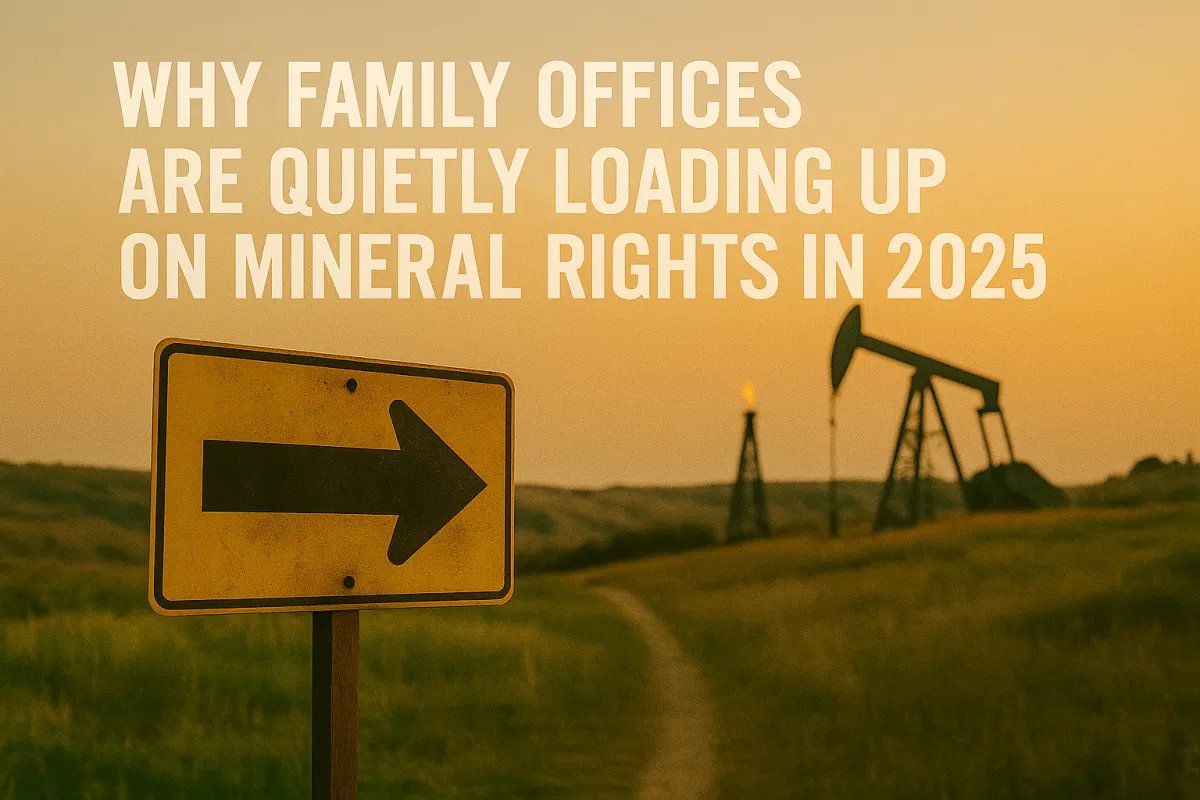
You won’t see it on the covers of Forbes. You won’t hear about it at the real estate conferences. But behind the scenes...
The world’s most sophisticated capital (family offices, private wealth groups, ultra-HNW investors) is quietly shifting allocations toward mineral rights—and the reason is simple: the risk / reward profile is starting to look like the best of both worlds.
🚨 If you want the full playbook—how they structure deals, pick basins, manage risks, and preserve legacy—KEEP READING. At the end, you’ll find the best place to get all the fundamentals and trade-offs laid out at zero-cost to you! We host a deep dive webinar that unlocks critical secrets, so grab your complimentary seat today.
The Quiet Reallocation Underway
Family offices are known for capital allocated thoughtfully over generations rather than chasing short-term gains. But the past decade of low yields, rising asset competition, and market volatility has forced smart offices to rethink their real asset exposure.
What’s Changing:
Yield compression in real estate: As more capital floods into real estate, cap rates tighten, margins shrink, and operational burdens eat into returns.
Desire for low-maintenance income: Family offices don’t want to be landlords. They want streams of cash that require minimal oversight.
Higher upside optionality: Mineral rights, especially in well-positioned basins, offer the potential for new drilling, royalty growth, and geological upside.
Tax, legacy, and control: As mineral estates are separable from surface estates, they offer structural flexibility in governance, estate planning, and intergenerational transfers.
The Result: a growing number of offices are quietly deploying capital into mineral interests—not in speculative plays, but in producing, cash-flowing assets with upside.

What They See In Mineral Rights That Real Estate Doesn’t Offer
1. Cash Flow with No Tenants, No Maintenance--
Once a mineral lease is in place, the operator handles drilling, operations, inspections, repairs, and regulatory overhead. The investor simply receives royalty checks. No tenant disputes. No vacancies. No plumbing emergencies.
2. Asymmetric Upside + Optionality--
Mineral rights offer a base stream plus upside optionality. If new wells find pay zones, adjacent acreage is developed, or technology improves, value can lift substantially. Meanwhile, you’re already collecting income.
3. Legacy Structuring & Estate Efficiency--
Because mineral ownership is separable, family offices often build trust, partnership, or operating vehicle structures around them. They can hand down mineral interests without the same drag that comes with managing land and buildings. It becomes a cash-producing legacy that doesn’t require managing tenants or properties.
4. Inflation Correlation & Hedging--
Commodity prices (oil, gas, minerals) often rise with inflation. Mineral royalties move more directly with those cycles. Real estate does too, but rent escalations lag leases and often come with friction. Mineral income can act as a more direct hedge in inflationary regimes.
5. Edge & Access Barriers--
Because mineral investing requires domain knowledge, title diligence, geological insight, and local relationships, competition is lower. Offices willing to build or acquire that internal expertise can access deals others won’t see or understand.
How They're Doing It In 2025 (Examples & Moves)
While many offices remain discreet, certain structures and transactions hint at the momentum:
Some have launched *1031-exchange–friendly mineral & royalty portfolios**, letting real estate investors roll into minerals without triggering large tax events.
Others are forming *co-invest or joint venture deals** with specialized mineral operators or funds to deploy capital at scale but limit hands-on exposure.
A few have started acquiring *non-producing leased acreage** in high-potential basins, betting on future drilling and development as pipelines and infrastructure expand.
* More offices are hiring dedicated subsurface / land teams to evaluate deals—mirroring real estate asset teams but for the subsurface.
📈 The pattern is clear: they aren’t dabbling. They're building capacity.
The Trade-Offs They Guard Against
Yes, family offices see the upside—but they also don’t ignore the risks. Here’s how they mitigate:
Stick to producing or near-producing assets: Minimize dry hole or drilling delay risk.
Stress-test commodity cycles: Model base, bear, and bull oil/gas price cases and see what happens to royalty income over 10+ years.
Scrub title and lease structure hard: Any cloud on ownership or confusing lease clauses is rejected.
Limit leverage: They often use cash or low debt; mineral financing is more complex and risky.
Exit paths must be clear: They want defined routes—selling royalty streams, partial carve-outs, or opportunistic sale of acreage.
* When suite-level capital meets patience and discipline, the rewards can be substantial—and the risks controllable.

Why This Matters To You
If family offices are stepping in, that tells you two things:
1. Competition is coming—getting in early, understanding how deals are structured, and building relationships matters more than ever.
2. The opportunity set is expanding—the next decade will see more deals, better transparency, and more capital flowing into minerals.
* You don’t need to be a family office to play. But if you want to invest intelligently, you’d be wise to see it through their lens: cash flow + optional upside + low overhead + legacy alignment.
Want the Full Playbook? Join Our FREE Webinar
We’re hosting a live (and on-demand) webinar for investors, advisors, and wealth allocators that will walk you step-by-step through mineral ownership fundamentals:
What we’ll cover:
What mineral rights actually give you (royalties, leasing, bonus structures)
How family offices underwrite deals (valuation, production curves, decline modeling)
Legal, title, lease, and due diligence frameworks they refuse to compromise on
Tax strategies, structuring for legacy, and exit path design
Mistakes to avoid (overpaying, weak leases, hidden deductions)
Real-world case studies of deals being done in 2025
Who should watch:
Real estate investors looking to diversify
Wealth managers and advisors exploring alternative income
High-net-worth individuals seeking tax-efficient long-term income
Deal sponsors, brokers, and capital allocators wanting to understand market expectations
How to Register:
CLICK HERE to register for the upcoming session or get access to the on-demand replay. **Seats limited**

